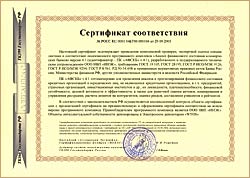 |
Российские технологии для успешного бизнеса |

Brief Description of the Commercial Banks' Financial Standing Analysis software complex (PK AFSKB)
|
|
The PK AFSKB Winner Certificate
|
|
|
Certificate of Compliance of the PK AFSKB v. 4.1.
|
The Commercial Banks' Financial Standing Analysis software complex (PK AFSKB) is meant for conducting professional financial analysis of:
- credit organizations and their affiliates
- legal entities of the non-credit organization status
The PK AFSKB can be of use when performing the following:
a) internal financial analysis
- systematic, including the daily one;
- forecasting financial standing
- control over fulfilling regulations
- planning and management of resources
- work efficiency evaluation
- audit and business evaluation
b) external financial analysis
- regular monitoring of counteragents financial situation;
- estimation and control of financial risks;
- formulation of rankings, ratings and classifiers;
- drawing up analytical reports and motivated conclusions;
c) calculating credit limits
- for one counteragent;
- for a pool of counteragents considering and without considering statistical interactions;
- calculation of the required reservation level.
The PK AFSKB is recommended to be used in routine or systematic work for execs and employees of credit and non-credit organizations in such structural departments as:
- analytical
- crediting
- risk control and management
- planning and economic
- resource management
- investment
- internal control and audit
- economic security
The PK AFSKB is recommended for and successfully used by not only credit institutions, but also specialists of non-credit organizations, such as investment, consulting and management companies, audit firms, rating agencies, insurance companies, major holdings, educational establishments, bodies of state authority and government.
During 10 years of its exploitation by Russian and foreign institutions the PK AFSKB complex has gained a reputation of a convenient, reliable, flexible and efficient instrument. It enables professional analysts to monitor organizations-counteragents, using methods included into the software complex, as well as their own methodical developments.
The PK AFSKB enables a professional analyst to realize a network of technological operations in the most coherent and convenient way. The complex designers have worked out their product mainly for economists, who have no command of programming languages, and no basic knowledge of software engineering. The analytical apparatus of the software complex and analytical methods input in it make it possible to estimate tentative, operational, final and perspective financial activity of organizations within any time-period, using traditional methods of analysis, groupings, comparison, ratios, share participation, chain substitutions, etc.
The PK AFSKB provides for an opportunity to carry out structural, dynamic, graphic, statistical, rating and forecast analysis. The number of methods, composition of estimated indices, quantity of institutions and time-periods under review is not limited. Methods technologies provided integrally with the software complex consist of analytical tables, indices and ratios with their description, patterns, formulas and calculation schemes.
List of Methods for Analyzing Credit Institutions, Developed by the INEC Specialists and Provided with the PK AFSKB complex
The CAMEL methods:
CAMEL summary rating.
Methods of express analysis of the "INEC-Calypso" bank (note):
analysis of income and expense structure.
Criteria for bank admission to the system of deposit insurance (note):
Liquidity evaluation indices
Methods of crediting limit calculation:
Combining traditional approach and the INEC
Methods of analyzing asset-liability operations:
Urgent operations' analysis
Bank investment operations;
Analysis of authorized capital.
Numerous ratios and indices, characterizing different aspects of banking activity and financial standing of a credit organization, are calculated and analyzed integrally by the methods technologies. Among them are as follows:
efficiency indices characterizing profitability of the bank activity and profitability of deposits (asset profitability ROA, profitability of operational assets ROA1, capital multiplier EM, capital profit ROE, authorized capital profit, profit margin PM, asset use AU, net interest margin, net securities margin, net currency margin, other operations' net margin)
Sources of original data, applicable for credit organizations analysis
1) bookkeeping accounts
form 101 (turnover balance sheet);
2) the profit-and-loss symbols
form 102 (profit-and loss report);
3) reporting forms, approved by the Bank of Russia, other government and supervisory authorities
published reporting, etc. ;
4) forms of international standards for financial reporting (GAAP, IAS, etc.);
5) reporting in standards of foreign states, union, associations, cartels, consortiums;
6) optional forms;
7) non-finance information. List of analysis methods for non-credit legal entities, designed by the INEC specialists and provided in the PK AFSKB:
Methods of organization analysis (note):
analysis of net asset cost of a joint-stock company.
Methods of analyzing insurance companies (hereinafter - insurer):
insurer net asset cost analysis .
Methods of analyzing a professional securities market participant - investment company (hereinafter - investment company ):
investment company activity profitability;
Methods according to the Regulations of the Bank of Russia N 218-П
dd. March 9, 2003г.:
Evaluation of financial standing of insurance organizations - founders (participants) of credit organizations;
Methods according to the draft Instruction of the Bank of Russia N 62а (draft) analysis of loan organizations (note)
summary evaluation table.
Methods according to the draft Instruction of the Bank of Russia N 62а and и Regulations of the Bank of Russia N 232-П (variant suggested by INEC) (note):
Total List Ratios
Sources of original data applicable for analyzing non-credit legal entities:
1) data according to bookkeeping accounts
turnover balance sheet;
2) forms of annual and intermediate accounting control, tax accounts, statistical and other reporting of:
private superannuation fund, etc.;
3) forms of reporting, approved by government and supervisory bodies
joint-stock companies' reporting on net asset cost, etc;
4) reporting forms in international standards of financial reporting (GAAP, IAS and others.);
5) reporting in standards of foreign states, union, associations, cartels, consortiums;
6) optional forms;
7) non-finance information.
Initial data for the PK AFSKB analysis can be input manually or imported in automated mode:
- in software formats, distributed by the Bank of Russia (Balance, Obved);
- in formats, approved by the Tax Ministry of the Russian Federation for further submitting to the Tax Ministry's institutions.;
- in formats, approved by the Russian Finance Ministry, for insurance companies' reporting to be submitted to insurance supervision department.
- In formats, accepted by the federal commission on securities for issuer and professional securities market participants reporting в форматах;
- In fixed user formats, including formats of the automated bank system (ABS) or organization's accounting office;
- In the format of the 1-C Enterprise software program (to import turnover balance sheet);
- In the INEC in-house format;
- In optional formats.
The PK AFSKB sets forth an opportunity to input optional quantity of data bases:
- For credit and non-credit organizations (irrespective of country location, and forma of financial reporting);
-
With different types of accounts, including:
- Customer accounts - for credit organizations;
- Sub-accounts - for non-credit organizations;
- With different monetary "basis".
Additionally, the database may be supplemented with any reference information, changeable in time and characterizing outer economic environment: the beginning of a financial year, currency exchange rates, interest rates, regulations, etc.
When performing calculations the software complex ensures high speed of processing huge information volumes in the PK AFSKB database, and if the Terminal Services ОS Windows NT/2000 services are used, the rate of information processing swells many times.
The PK AFSKB complex enables a specialist to prepare an analytical report, required by the company management, drawn-up as a motivated summary, in the shortest possible time (text description, tables and graphics). In doing so, the text part of the document and conditions for its forming can be set independently by the complex user, when forming a text interpretation of indices and ratios, received as a result of analysis.
Versatile open platform, full methodological "transparency" and quite a few settings enable the user to independently adapt the PK AFSKB to different changes, in particular, in respect of accounts' plan, reporting forms or regulations, and, in compliance with the changes, to easily correct available methodical applications in automatic mode.
Depending on the analysis aims the instrumental means of the software complex enable the user to create unlimited quantity of different methods, independently adapt the PK AFSKB complex to the user ideology and work conditions, and these operations do not require any knowledge of programming language and basics - the "meccano set principle."
Besides, specialists of the Analysis and Reporting for Credit Organizations trend, who have gained a many-year experience, are always ready to help users to transfer their own methodical developments to the software complex, or, according to terms and prices, indicated in the price list , realize any analysis methods in the PK AFSKB complex in compliance with a customer request.
|
© 2009-2022 ООО ИНЭК-ИТ
Тел.: (495) 786-22-30 (многоканальный) market@inec.ru |

